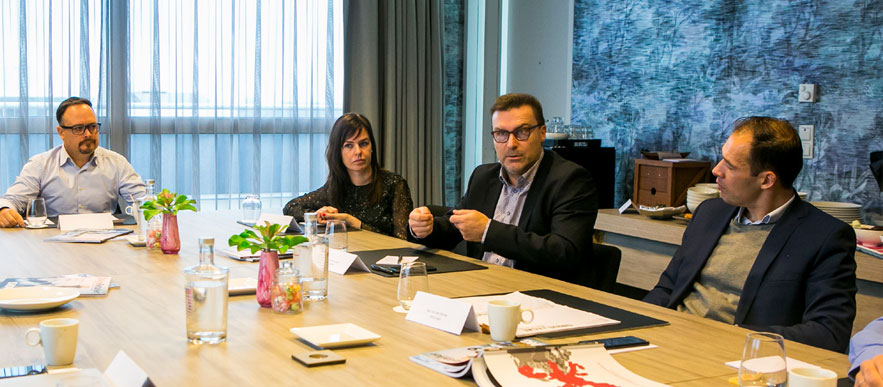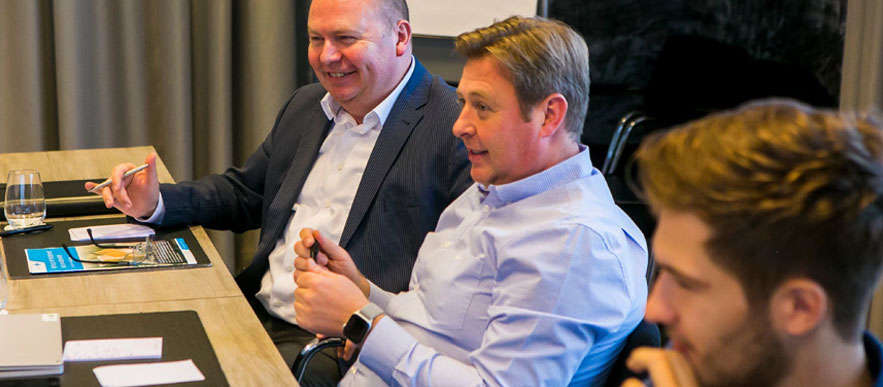E-commerce is running at full speed. Records are broken every year in the number of online spending and online turnover. E-commerce is also a dynamic market. What will the world look like in 2020 and what should (r)etailers be buying? We ask a large number of experts from different fields during our Round Table Session with the theme Future of E-commerce.
Online
How will consumers shop in 2020? According to Tonny Verweij of Kraftmaker, this mainly happens online. “Offline spending will decline,” he expects. “Saturdays in cities are not nearly as crowded as they were years ago. But the vicissitudes surrounding Ikea are also an example of the shift in the market. Ikea itself states that the company has stepped into e-commerce too late and is now forced to reduce its workforce.” Guido van der Ven of bol.com also shares this opinion. “Consumers will mainly shop online and mainly via smartphone-apps or even in the car through smart speakers. It is expected that the consumer will no longer shop at multiple webshops, but via a few one-stop webshops, where the range of several suppliers comes together. a shop that consumers are familiar with.” Luc Van den Broeck of Tailorfit also sees the shift to online. According to him, it is segment bound. “Fashion, for example, can almost be split in two: men and women. Women still see the fun of a midday of shopping. Men shop differently, more functionally. When a pair of pants is good, they are immediately bought in three colors and if possible with a shirt or two.”
Upsell
Despite the differences in the way of shopping, according to Luc Van den Broeck, both men and women absolutely benefit from a complete integration of online and offline. “Especially when it comes to returned articles. It is important to also be able to deliver them to the physical store. In many cases, that means an upsell of more than 50%.” Bart Van den Brande can also confirm this. “It ties in with the conclusions of a digital marketing conference I attended recently. In addition, I would like to nuance Tonny’s statement that everything will happen online in the future. The future is truly omnichannel. You cannot separate one channel from the other.” Guido van der Ven: “With a good omnichannel experience, the consumer does not experience any friction when switching between sales or usage channels.
Consolidate
According to Wim Van Loo of Slimstock, the market is starting to consolidate a bit. “From an unmistakable consumer trend to want to buy everything online, you now notice that they cannot do without the physical store. More and more retailers are also able to combine the best of several worlds: omnichannel indeed. For the consumer, this only offers advantages, such as trying on in the store, returning an item in the store they bought it or in another store of the same chain. These are things that the consumer appreciates very much. The retailer’s structure must be geared to this. That means a sophisticated infrastructure, integrated software, and more.”
The service level is also very important in this story, says Jimmy Depaepe of TCOG. “The webshop can be seen as an extension of the physical store. The service level must be the same on all channels, such that the customer buys from you and not from your competitors.” Guido van der Ven: “The game of entrepreneurship is adapting oneself to a world that is in motion. A business strategy that fits the shopping behavior of consumers is a business strategy that is sustainable. Look at where you can digitize first, for example in your customer base, and formulate an ambitious goal. In addition, you can start a webshop yourself, but if you do not have the financial possibilities or the knowledge, you can also offer your range via a platform. This way you can focus on your own strength and combine it with the strength of an e-commerce platform. A combination of clicks and bricks.”
Dynamic
Kurt Pinoy of Premium Plus fully agrees with what Jimmy Depaepe says about the service level that should be the same on all channels: “The customer experience is the determining factor, not the price and the product. We see that in the market and you absolutely need an omnichannel experience for that.” Addy Rijkens of PostNL can confirm this and adds: “The game that is being played today is about the battle of the experience or the customer experience. That determines where the consumer buys, how he buys and when he buys. It doesn’t matter whether it’s online or offline. Consumers do not think in terms of channels, they want to be able to buy when it suits them. Whoever can give the best experience to the consumer is the winner. But an experience is also something very dynamic. The experience that we now experience as a consumer could just be different in six months.” Kurt Pinoy: “You will indeed have to surprise the consumer again and again. Even though Ikea may have stepped in online too late, they are now taking serious steps in the field of omnichannel. For example, they have launched an app that allows you to take a photo of the living room, so that the consumer can see how the new seat fits into his interior. Another app from a UK start-up combines all bank cards. If you made a purchase today, you still have a week to switch cards. That’s experience. There is still room for small players with fantastic ideas.” Wim Van Loo: “Consumers always expect a bol.com service.”
Speaking of experience, according to Bart Van den Brande, voice commerce will also take off. “At the same conference, it was stated that by 2022, half of searches online would be via voice. But that comes with quite a few challenges. How should you, as a fashion retailer, prepare for this, for example? I don’t see it happening yet to order blue pants via a smart speaker.” Addy Rijkens sees few limitations. “If your profile with preferences, sizes and colors is known, a clothing selection can be made quite accurately, also via voice.” Kurt Pinoy also believes that the technology has already come so far. “Consumers want to be unburdened as much as possible and prefer not to be contacted by telephone or chat. He wants to be able to find his own way to the right product and preferably as quickly as possible. Voice certainly offers opportunities when it comes to proactively approaching consumers.” The consumer does indeed want to be proactively informed, Guido van der Ven also believes. “Self-searching the range, which consists of tens of thousands of articles, is complex and time-consuming. It simply won’t make you happier. The consumer will require the shop to be known and to receive advice/offers that suit his or her life. This will therefore take place more through, for example, mobile notes, push messages or smart speakers that act as personal assistants. The technologies are already there and will be adopted faster than ever in 2020.” Wim Van Loo: “We can predict a lot today, the technology can do a lot, but the formulas on which statistics are based are sometimes fifty years old or more. When it comes to specific needs and proactive approach, we eventually come to Artificial Intelligence or AI. It seems complex, but it is definitely the future. And that happens faster than you think.” Jimmy Depaepe can confirm this: “If you look at the budgets Microsoft has already invested in AI, that is huge. The phone will ‘think proactively’ and will suggest what the consumer wants to buy. AI is becoming more concrete.”
GDPR puts the brakes on experience
AI may be becoming more concrete, but to be able to individualize AI, you need an incredible amount of data, says Bart Van den Brande. “And where can you legally get that data from and what can you do with it? For example, the French privacy government has decided that the data of a company that builds profiles and offers it for sale for real-time bidding advertisements is not regularly collected and may not be used. This is a database with 60 million people for whom no one has ever given permission to build the profiles. The fines that have been handed out under the GDPR in recent months are no laughing matter. It is a huge challenge of what you can do with AI with legislation that is becoming stricter.” Kurt Pinoy: “There are plenty of opportunities with AI for customer service, also under the GDPR. Thanks to AI, self-help is increased and recurring questions will stop. Customer service can then deal with really challenging matters. Again, it is about an effortless experience for the consumer.”
Bart Van den Brande: “Of course there are possibilities, but I just want to point out that retailers should continue to pay attention. This also applies to an omnichannel environment, in which people try to connect the online and offline experience. Targeting consumers online when they are near the physical store is actually not allowed. Google is accused of systematically keeping location data in violation of the GDPR because a clear opt-in has never been obtained.” According to Jimmy Depaepe, it will always be a ‘battle’ to what extent consumers are willing to share data. Romy Vandevelde of Combell sometimes also sees it as a form of blackmail. For example, if you want to use an app without the ads, you need to register first. Or if you want to win a prize, you have to leave your details first. Bart Van den Brande: “Once again this is contrary to the GDRP. If you give permission, your data must be ‘free’. That means you should not be blackmailed.” Guido van der Ven: “As a retailer, if you have pure and well-thought-out reasons for converting data into information, then that data will be awarded to you by customers. You can then use it to help them. Machine learning is a great way to achieve your goals with data. For example, you can use machine learning to generate personal recommendations based on real-time click behavior.”
Serial killer
Luc Van den Broeck notes that many retailers first have to overcome some other obstacles before they can start with modern techniques such as AI. “Most retailers are fighting with technology. They are tied to old IT infrastructures with cumbersome ERP systems that are internally focused. A concept that dates back to the 1980s. The playing field today has completely changed. The retailer must be able to service the consumer in all fields, preferably in real-time. Old systems present serious shortcomings in this regard.” Kurt Pinoy puts it aptly: “It is the consumer who has become a serial killer. The consumer decides and rules.” But at some point the bottom is reached, Jimmy Depaepe believes: “Then you will simply have to pay for extra service. There are no more margins today. Bart Van den Brande: “These consequences are already visible. For a few years now, we have noticed that the number of webshops in Belgium does not evolve, while a huge number of new ones are added. That also means that a huge amount is lost at the bottom.”
Tonny Verweij does have an explanation: “They are often also swallowed by large companies and marketplaces. In terms of pricing strategies, companies are also becoming more aggressive. Think of Mediamarkt with its real-time price tags. It is no longer feasible for small companies to go along with this.” Moreover, today’s consumer also has the opportunity to compare products and prices across dozens of webshops,” says Romy Vandevelde. “That is very time-consuming and confusing. Marketplaces make it much easier for consumers to compare within one platform. Using filters and sorting, you can immediately see where you can buy your product most cheaply. So you will really have to distinguish yourself in order to stand out and attract them to your individual webshop.” Kurt Pinoy: “Let’s come back to the experience again. Turn your customers into ambassadors by surprising them. Coolblue is a good example of this and is really not the cheapest.” According to Guido van der Ven, there is certainly still room for small and new players, as long as their offer is unique and specialized. “However, it does require more creativity and innovation.”
Competition
Coolblue indeed proves that you don’t have to be the cheapest. “Ikea has a different strategy, even though they got in late online,” says Romy Vandevelde. “If you order something online, the shipping costs are often higher than the value of the package. Yet you are not going to the competition, you are still going to pick up the package in the physical store. I think this is because of their own offering. You cannot buy a specific Ikea furniture exactly the same from a competitor, so you make the extra effort. They differentiate on their product range. An own brand is one of the few possible differentiators to survive. Then you don’t necessarily have to offer shipping for free.” There are not many brands that can afford that, says Luc Van den Broeck. Addie Rijkens: “Yet Ikea is growing very fast online. Forecasts are always adjusted upwards, while they do not promote the webshop at all.”
Wim Van Loo believes that the importance of the CFO is again much more important than a few years ago. “The margin on an article is calculated again, what the advertising campaign has cost, how the range is geared to this, etcetera. Theories that have been used less than twenty years are resurfacing.” Jimmy Depaepe: “Twenty years ago that was not necessary, because a margin was made and that margin is now gone.” Bart Van den Brande: “If the margin is gone now, I fear the worst when the Geo-blocking Regulation and the Parcel Directive are introduced. Europe is committed to transparency and a single market. For example, web shops from other European member states may no longer be blocked and there will be more transparency on the market for cross-border parcel transport.
In promotion
Wim Van Loo also sees a counter-movement in Belgium. “Retailers are increasingly letting go of the classic sales periods. There are products that are on promotion almost all year round. You can continue to do that, but you have to rebuild the entire cost model.” Are retailers not obliged to do that, wonders Kraftmaker’s Junior Bauwens. “If they don’t, they won’t survive. You need to attract people to your website or store. And what are the standard methods? Indeed, a unique assortment, a discount or, looking for other ways, an artist who comes to perform.” Addy Rijkens: “It is also a strategy to promote certain products and then encourage the purchase of products that do make a margin.” Luc Van den Broeck: “As a result of the single market and pressure on margins, commodity retailers will experience a downward spiral. There is always a supplier who can deliver it cheaper. The retailers that survive have a strong brand name and a unique range. Only then will you get healthy online sales in addition to healthy offline sales.” And a lean organization, adds Wim Van Loo. “Retailers must continuously look at what the consumer wants, what the competition is doing and what is legally possible. So they have to look at the market in a different way and be more cunning.” Luc Van den Broeck: “Omnichannel was originally a strategy in response to the emerging e-commerce. Today everyone talks about omnichannel, but they forget the business strategy that should form the basis. This requires a great deal of technological flexibility and most of them refuse to do so. However, you will have to get that under control, otherwise you will soon be out of business.”
Marketplaces
How do the experts view the rise of marketplaces? According to Jimmy Depaepe, it is a win-win for both the retailer and a marketplace in the short term, but as time goes on, the retailer has less and less control over its customers. “All data is with the marketplaces. They see who is buying, what they are buying, what the best prices are. When a product group is doing well, there is a chance that marketplaces will build up a stock themselves. That can be fatal for a retailer.” Bart Van den Brande: “Even from a European perspective, people are concerned about the clout of major players. There is a draft regulation that should ensure more transparency between retailers and marketplaces.” Guido van der Ven: “You never have to fear giants if you yourself are relevant to the consumer. For a marketplace or a platform, the challenges are slightly different, it is not only about offering a relevant range, but also about marketing the platform itself. Obtaining a preferential position as a one-stop webshop because you are close to your customer, because you understand his or her life and connect with it. With last mile options, with personal service, but also, for example, with good marketing. We believe in the power of local relevance by bundling the offer and knowledge of Belgian entrepreneurs in a marketplace.” Success is largely in your own hands, says Wim Van Loo. “If you want to be and remain successful in the long term, you simply need partners. Partners with expertise, also in the legal field. ”A lawyer: better sooner than later,” jokes Bart Van den Brande. “On the other hand, you could also use marketplaces to look at opportunities abroad.” Jimmy Depaepe: “Export is especially interesting for brands with their own products. I think it will be very difficult for ‘box pushers’.” It is also a matter of daring, says Addy Rijkens. “Vente-Exclusive and Torfs are very successful in the Netherlands, despite the apparently saturated market.”
B2B Commerce
Another growth market in Belgium is B2B ecommerce. “It grows very fast, but it stays a buit under the radar,” says Addy Rijkens. Wim Van Loo can also confirm this: “In the beginning there was mainly a catching-up movement, but in the meantime it is perhaps growing even faster than B2C ecommerce.” Logical too, thinks Jimmy Depaepe. “It offers many advantages and if you do it right you can serve both B2B and B2C via one platform.” That is also what they must do and where the future lies, says Wim Van Loo. “B2B customers also have a Coolblue expectation. But that again requires a lean organization in which the different systems have to talk to each other. Luc Van den Broeck: “Coming back to the often cumbersome systems with which B2B players are often equipped. In the new world you want to link those producers to your retail systems. Retailers already have a problem if their knowledge is spread over checkouts, kiosks and the webshop. Integrating these own ‘silos’ and their B2B partners requires an underlying omnichannel platform from which all channels are centrally served.”
Thanks to this far-reaching integration, Bart Van den Brande notes that brands are also increasingly able to serve the market themselves. “They sidelined wholesalers, distributors and networks, a very painful evolution.” Wim Van Loo: “Strapping the central channel is a short-term vision. The distribution channel offers many advantages, especially with a view to the relocation of the stock, which was discussed earlier. Those benefits are not weighed up enough.” It is also often a decision that (once again) arises from technological limitations, concludes Luc Van den Broeck. The experts at the table therefore agree that there are certainly plenty of opportunities for retailers in the future, both online and offline. Also for the smaller players. They will have to set up lean and excel in experience. On all levels.
Texts: Roel van Gils
Visuals: Roel Wijnen




